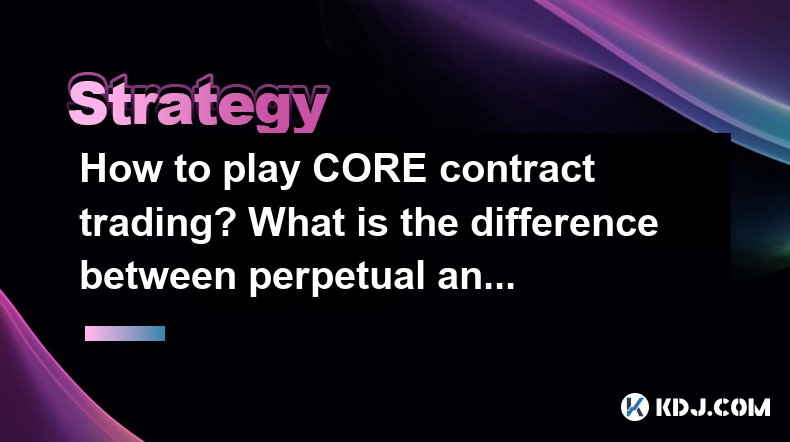-
 bitcoin
bitcoin $123963.239194 USD
1.37% -
 ethereum
ethereum $4529.082464 USD
1.07% -
 xrp
xrp $2.983640 USD
0.71% -
 tether
tether $1.000287 USD
0.02% -
 bnb
bnb $1179.874393 USD
2.99% -
 solana
solana $230.633678 USD
1.55% -
 usd-coin
usd-coin $0.999835 USD
0.03% -
 dogecoin
dogecoin $0.254240 USD
1.34% -
 tron
tron $0.341176 USD
0.15% -
 cardano
cardano $0.842285 USD
0.52% -
 hyperliquid
hyperliquid $48.537896 USD
-0.86% -
 chainlink
chainlink $21.863092 USD
-0.84% -
 ethena-usde
ethena-usde $0.999743 USD
-0.07% -
 sui
sui $3.579561 USD
-0.18% -
 stellar
stellar $0.403418 USD
2.67%
How to play CORE contract trading? What is the difference between perpetual and delivery contracts?
CORE contract trading on the blockchain involves perpetual and delivery contracts; perpetuals have no expiration, while deliveries must be settled at a set date.
May 07, 2025 at 10:35 pm

Introduction to CORE Contract Trading
CORE contract trading refers to the process of trading financial derivatives on the CORE blockchain platform. These derivatives are known as contracts, which can be either perpetual or delivery contracts. Understanding how to play CORE contract trading involves knowing the mechanics of these contracts, as well as the differences between them. This article will guide you through the process of engaging in CORE contract trading and clarify the distinctions between perpetual and delivery contracts.
Getting Started with CORE Contract Trading
To begin trading CORE contracts, you first need to set up an account on a platform that supports CORE blockchain transactions. Here is a detailed step-by-step guide on how to get started:
- Choose a trading platform: Select a reputable exchange that supports CORE blockchain trading. Examples include platforms like Binance or OKEx.
- Register an account: Fill out the registration form with your personal information and complete the verification process.
- Fund your account: Deposit cryptocurrency into your trading account. Ensure that you have enough funds to cover potential margin requirements.
- Navigate to the trading section: Once your account is funded, go to the derivatives trading section of the platform.
- Select CORE contracts: Look for CORE perpetual or delivery contracts in the list of available trading options.
Understanding Perpetual Contracts on CORE
Perpetual contracts, also known as perpetual futures, are a type of derivative that does not have an expiration date. They allow traders to speculate on the future price of an asset without the need to settle the contract. Here's how they work on the CORE platform:
- No expiration: Unlike traditional futures contracts, perpetual contracts do not expire, allowing traders to hold positions indefinitely.
- Funding rates: To ensure that the price of perpetual contracts remains closely aligned with the underlying asset's spot price, a funding rate mechanism is used. Traders who are long on the contract pay a funding fee to those who are short if the funding rate is positive, and vice versa if the funding rate is negative.
- Leverage: Perpetual contracts often allow for high leverage, which can amplify both gains and losses.
Understanding Delivery Contracts on CORE
Delivery contracts, on the other hand, are traditional futures contracts that have a set expiration date. At the expiration date, the contract must be settled, either through physical delivery of the asset or through cash settlement. Here's how they work on the CORE platform:
- Expiration date: Delivery contracts have a specific expiration date, after which the contract must be settled.
- Settlement: Upon expiration, the contract can be settled by delivering the underlying asset or by paying the difference between the contract price and the spot price in cash.
- Lower leverage: Delivery contracts typically offer lower leverage compared to perpetual contracts, which can lead to more conservative trading strategies.
Key Differences Between Perpetual and Delivery Contracts
The main differences between perpetual and delivery contracts lie in their structure and trading mechanics. Here are the key distinctions:
- Expiration: Perpetual contracts do not expire, while delivery contracts have a set expiration date.
- Settlement: Perpetual contracts do not require settlement, as they can be held indefinitely. Delivery contracts must be settled at expiration, either through delivery or cash settlement.
- Funding rates: Perpetual contracts use a funding rate mechanism to align their price with the spot price, while delivery contracts do not have this feature.
- Leverage: Perpetual contracts often allow for higher leverage, which can lead to higher potential returns but also higher risk. Delivery contracts typically offer lower leverage, which can result in more stable trading strategies.
Trading Strategies for CORE Contracts
When trading CORE contracts, whether perpetual or delivery, it's essential to have a solid trading strategy. Here are some strategies to consider:
- Trend following: This strategy involves identifying and following the direction of the market trend. Traders can use technical indicators like moving averages or the Relative Strength Index (RSI) to determine the trend.
- Arbitrage: This strategy involves taking advantage of price differences between different markets or between the spot and futures markets. Traders can buy the asset in one market and sell it in another to profit from the price discrepancy.
- Hedging: This strategy involves using contracts to protect against potential losses in the spot market. For example, if a trader holds a long position in the spot market, they can take a short position in the futures market to hedge against price drops.
Practical Example of Trading CORE Contracts
To illustrate how to trade CORE contracts, let's walk through a practical example of trading a perpetual contract:
- Choose a contract: Navigate to the CORE perpetual contracts section on your trading platform and select a contract that you want to trade.
- Analyze the market: Use technical analysis tools to determine the current market trend and potential entry points.
- Place an order: Decide on the amount of leverage you want to use and place a buy or sell order based on your analysis.
- Monitor the position: Keep an eye on the funding rate and the market price to ensure that your position remains profitable.
- Close the position: When you're ready to exit the trade, place an order to close your position and realize your profits or losses.
Frequently Asked Questions
Q: Can I trade CORE contracts on any exchange?A: No, you can only trade CORE contracts on exchanges that support CORE blockchain transactions. It's important to choose a reputable platform that offers secure and reliable trading services.
Q: What is the risk of using high leverage in perpetual contracts?A: High leverage can amplify both gains and losses. While it can lead to higher potential returns, it also increases the risk of significant losses, especially in volatile markets.
Q: How do I calculate the funding rate for perpetual contracts?A: The funding rate is calculated based on the difference between the perpetual contract's price and the spot price of the underlying asset. It is typically expressed as a percentage and can be positive or negative, depending on the market conditions.
Q: Can I convert a perpetual contract to a delivery contract?A: No, perpetual contracts and delivery contracts are distinct financial instruments with different characteristics. You cannot convert one type of contract to the other, but you can trade both types separately on the CORE platform.
Disclaimer:info@kdj.com
The information provided is not trading advice. kdj.com does not assume any responsibility for any investments made based on the information provided in this article. Cryptocurrencies are highly volatile and it is highly recommended that you invest with caution after thorough research!
If you believe that the content used on this website infringes your copyright, please contact us immediately (info@kdj.com) and we will delete it promptly.
- BlockDAG, DOGE, HYPE Sponsorship: Crypto Trends Shaping 2025
- 2025-10-01 00:25:13
- Deutsche Börse and Circle: A StableCoin Adoption Powerhouse in Europe
- 2025-10-01 00:25:13
- BlockDAG's Presale Buzz: Is It the Crypto to Watch in October 2025?
- 2025-10-01 00:30:13
- Bitcoin, Crypto, and IQ: When Genius Meets Digital Gold?
- 2025-10-01 00:30:13
- Stablecoins, American Innovation, and Wallet Tokens: The Next Frontier
- 2025-10-01 00:35:12
- NBU, Coins, and Crypto in Ukraine: A New Yorker's Take
- 2025-10-01 00:45:14
Related knowledge

Practical parameter settings for a Bitcoin multi-timeframe moving average system
Sep 18,2025 at 10:54pm
Optimizing Timeframe Combinations for Bitcoin Trading1. Selecting appropriate timeframes is crucial when building a multi-timeframe moving average sys...

How can I filter out false breakouts in Dogecoin high-frequency trading?
Sep 22,2025 at 01:00am
Understanding False Breakouts in Dogecoin Trading1. A false breakout occurs when Dogecoin's price appears to move beyond a defined support or resistan...

Techniques for identifying tops and bottoms in the Bitcoin on-chain NVT model
Sep 20,2025 at 07:54pm
Understanding the NVT Model in Bitcoin Analysis1. The Network Value to Transactions (NVT) ratio is often described as the 'P/E ratio' of the cryptocur...

What does the surge in open interest in Bitcoincoin futures mean?
Sep 20,2025 at 11:18pm
Understanding the Surge in Dogecoin Futures Open Interest1. A surge in open interest within Dogecoin futures indicates a growing number of active cont...

How can I use the Ethereum USDT premium to gauge market sentiment?
Sep 18,2025 at 11:55pm
Understanding the Ethereum USDT Premium1. The Ethereum USDT premium refers to the price difference between USDT (Tether) traded on Ethereum-based plat...

What should I do if Ethereum staking yields decline?
Sep 20,2025 at 06:18am
Understanding the Causes Behind Declining Ethereum Staking Yields1. The Ethereum network transitioned to a proof-of-stake consensus mechanism with the...

Practical parameter settings for a Bitcoin multi-timeframe moving average system
Sep 18,2025 at 10:54pm
Optimizing Timeframe Combinations for Bitcoin Trading1. Selecting appropriate timeframes is crucial when building a multi-timeframe moving average sys...

How can I filter out false breakouts in Dogecoin high-frequency trading?
Sep 22,2025 at 01:00am
Understanding False Breakouts in Dogecoin Trading1. A false breakout occurs when Dogecoin's price appears to move beyond a defined support or resistan...

Techniques for identifying tops and bottoms in the Bitcoin on-chain NVT model
Sep 20,2025 at 07:54pm
Understanding the NVT Model in Bitcoin Analysis1. The Network Value to Transactions (NVT) ratio is often described as the 'P/E ratio' of the cryptocur...

What does the surge in open interest in Bitcoincoin futures mean?
Sep 20,2025 at 11:18pm
Understanding the Surge in Dogecoin Futures Open Interest1. A surge in open interest within Dogecoin futures indicates a growing number of active cont...

How can I use the Ethereum USDT premium to gauge market sentiment?
Sep 18,2025 at 11:55pm
Understanding the Ethereum USDT Premium1. The Ethereum USDT premium refers to the price difference between USDT (Tether) traded on Ethereum-based plat...

What should I do if Ethereum staking yields decline?
Sep 20,2025 at 06:18am
Understanding the Causes Behind Declining Ethereum Staking Yields1. The Ethereum network transitioned to a proof-of-stake consensus mechanism with the...
See all articles










































































